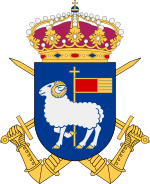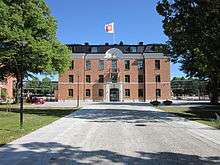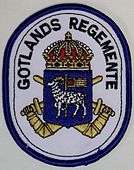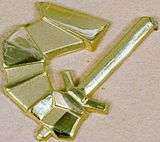Gotland Regiment
| Gotland Regiment (P 18) | |
|---|---|
| Gotlands regemente (P 18) | |
 | |
| Active | 1963–1994, 2000–2005, 2018– |
| Country |
|
| Allegiance | Swedish Armed Forces |
| Branch | Swedish Army |
| Type | Armoured regiment |
| Role | Mechanized infantry |
| Size | Regiment |
| Part of |
Milo Ö (1963–1982) MKG (1982–1994) Opil (2000–2005) Military Region Gotland (2018–) |
| Garrison/HQ | Visby |
| Motto(s) |
Regementet för framtiden ("The regiment of the future") |
| Colors | Blue and white |
| March | "In Treue Fest" (Teike)[not 1] |
| Mascot(s) | Harald the Ram[2] |
| Commanders | |
| Current commander | Colonel Mattias Ardin[3] |
The Gotland Regiment (P 18) (Swedish: Gotlands regemente) is a Swedish Army armoured regiment which has been active in various forms between 1963–1994 and 2000–2005, when it was disbanded. The regiment was re-raised on 1 January 2018.[4] The regiment is based in Visby as part of the Gotland Garrison.[5][6][7] The regiment is currently the youngest and smallest unit of the Swedish Armed Forces.[8]
History

In the Defence Act of 1958, the Riksdag decided that eight armoured brigades with new combat vehicles would be organized in the army. The decision was changed for economic reasons in August 1960 to include only seven armoured brigades.[9][10] Four infantry regiments, the North Scania Regiment (I 6), South Scania Regiment (I 7), Södermanland Regiment (I 10) and Gotland Infantry Regiment (I 18), were transferred from the infantry to the armoured forces.
There was a detachment of the Göta Armour Life Guards (Göta pansarlivgarde, P 1) on Gotland since 1944, the Göta Armour Life Guards Company at Gotland (Göta pansarlivgardes kompani på Gotland, P 1 G). The detachment was amalgamated on 1 April 1963 with the new Gotland Regiment, forming the backbone of the new armoured regiment. The Gotland Regiment was also given the new designation P 18 instead of its previous designation I 18 as an infantry regiment.[11]
As part of the so called OLLI reform, which was carried out by the Swedish Armed Forces in 1973 and in 1975, A units and B units were created. The A units were regiments responsible for a defence area and the B units were training regiments. In Gotland's case, the VII. Military Area was reorganized into Gotland Military Command (MKG) in 1966. The military command was a special command and control organization within the Eastern Military District, but did not have the overall responsibility for the administration of the island. The Gotland Regiment, which was included in the Gotland Military Command (MKG), was a B unit (training regiment) from 1 July 1974.[12]
Prior to the Defence Act of 1977, the Defence Peacetime Organization Commission (Försvarets fredsorganisationsutredning, FFU) proposed to the Riksdag that the Gotland Regiment (P 18), Gotland Artillery Regiment (A 7) and Gotland Anti-Aircraft Battalion (Lv 2) would be merged into one army regiment.[13] However, the Committee on Defence and the Minister for Defence felt that no decision would be taken before the issue of further land acquisition in connection to Visborgs slätt had been resolved. In the autumn of 1980, the issue was considered sufficiently resolved when the Riksdag decided on 16 October 1980 to merge the army units into an army regiment.[14]
From 1 July 1982 the regiment was subordinate to the commanding officer of the Gotland Military Command (MKG).[7] After the Defence Act of 1992, the Gotland Military Command received a new role. The command came only to lead all operations on Gotland, which on the mainland were settled by the defence area staffs, division staffs and naval command staffs. The army units, which since 1982 had been subordinate to the command, came to form independent units. However, the Gotland Regiment was merged with the war unit Gotland Brigade and formed the Gotland Regiment and Gotland Brigade (MekB 18).
Prior to the Defence Act of 2000, the government proposed to the Riksdag that only six units for training of army brigade commands and mechanized battalions would be the starting point for the future of the Swedish Armed Forces. When it came to Gotland, the government considered that operational requirements made it necessary to have a military presence on the island. Primarily because of cost and maintenance reasons, the government considered that no tank training would be carried out on Gotland. The Swedish Armed Forces' new peacetime organization did not come to reflect the war organization in the same way as before, which meant that Gotland Regiment and Gotland Brigade was decommissioned on 30 June 2000, and in its place the Gotland Regiment (P 18) was re-formed on 1 July 2000.
In the Defence Act of 2004, the Riksdag decided on disbanding the Gotland Regiment (P 18). Prior to the Defence Act, the regiment was put up against the Jämtland Ranger Regiment (I 5), South Scania Regiment (P 7) and Södermanland Regiment (P 10), where the government was keen to create rational production conditions, and a sustainable organizational structure. The new organization would respond to the requirements of the new structure of operational units and the development and training resources. Each regiment trained mechanized units, and had good production conditions and good engineering resources. The government wanted the Swedish Armed Forces to be developed into an operational defense, with a greater emphasis on internationalization, which came to mean that the government proposed disbanding the Gotland Regiment. Of the other three regiments, only the South Scania Regiment remained, the other two also being disbanded. The government considered the South Scania Regiment had the best geographic location, with proximity to the training area, which was central to the Swedish Armed Forces. The government also regarded it as important to have military units with emphasis on ground warfare in southern Sweden, with short distances to both the Øresund Bridge and Barsebäck Nuclear Power Plant.[15]
The Gotland Regiment was disbanded on 31 December 2004. From 1 January 2005, the regiment changed name to the Decommissioning Organization P 18 (Avvecklingsorganisation P 18), which would account for the disbandment of the regiment, which would be completed on 31 August 2006. On 28 May 2005 the official disbandment of the regiment took place.[16][17]
In September 2017, the Minister for Defense presented the proposal that the regiment would be re-formed on 1 January 2018. The Riksdag confirmed the decision on 13 December 2017.[4] On 22 May 2018, the regiment was officially consecrated by King Carl XVI Gustaf, Prime Minister Stefan Löfven and General Micael Bydén. The regiment is expected to be staffed by 30 men and women by the end of 2018[8] and will reach its full strength of 350 by 2020.[18]
Campaigns
Organization before disbandment
2003-2005
- 1st - Life Company, officer and NCO training
- 2nd - Roma Company, five platoons including three mechanized platoons using Combat Vehicle 90, one missile platoon using Pansarvärnspjästerrängbil 1119 with a mounted BILL 1 Anti-tank guided weapon, and one support platoon using armored recovery vehicles, combat medics and forward command vehicles.
- 6th - Garde Company, staff and support company
- 8th - Havdhem Company, a battalion headquarters platoon, a battalion reconnaissance platoon, a battalion mortar platoon and a company support platoon.
-2003
Organization until 2003:[20]
- 1st - Life Company, officer and NCO training
- 2nd - Roma Company, mechanised infantry (1991-92 anti-tank missile company, 1992-93 brigade reconnaissance company)
- 3rd - Tingstäde Company, headquarters company, anti-tank missile company, staff and support (including battalion medical care). In the 1970s and early 1980s the company was an armored infantry company. From the mid 1980s to 1991, the company was a so-called military preparedness company
- 4th - Lärbro Company, tank company
- 5th - Klinte Company, depot and guard-duty
- 6th - Garde Company, staff and support
- 7th - Hemse Company, technical resource and mechanic school. Was organized in 2003, was renamed technical unit in 2003.
- 8th - Havdhem Company, command & control, formed 1 January 2001
Barracks and training areas
Barracks
On 30 August 1905, the regiment moved into a newly built barracks establishment at Visborgs slätt, which the regiment had as its meeting place and military camp since 1887. The barracks establishment was built as part of the 1901 Defence Reform's building program according to the Fortifikationen' type drawings for infantry establishments. In total, just over a hundred buildings were built in the area.[21] The barracks area has a number of times been expanded with garage and storage buildings and barracks. The Gotland Anti-Aircraft Corps and the Gotland Artillery Regiment were co-located with the Gotland Regiment, in 1978 and 1986 respectively. The staff of the Gotland Military Command and Gotland Military District have also been based in the barracks. After the regiment was disbanded, the Swedish Fortifications Agency sold the entire barracks area for about 40 million Swedish krona.[22]
Training areas
The regiment's primary training areas were in Visby, Stånga malm, Blekväten, Vallstena, Hällarna and Tofta firing range.[5]
Heraldry and traditions
When the regiment was reorganized into an armoured regiment in 1963, the regiment carried colours presented to the regiment on 13 June 1954 by the Chief of the Army Carl August Ehrensvärd. The regiment also for some time carried the colours of the Göta Armour Life Guards Company at Gotland (Göta pansarlivgardes kompani på Gotland, P 1 G) alongside their own colours.[5] A new colour was presented to regiment at the Oscar Memorial Stone (Oscarsstenen) in Visby by His Majesty the King Carl XVI Gustaf on 12 October 2002. The colour was drawn by Kristina Åkerberg and embroidered by machine and hand in insertion technique by Maj-Britt Salander. Blazon: "On blue cloth the provincial badge of Gotland; a white ram passant, arms and crosstaff yellow and a red banner with edging and five flaps in yellow."[23]
In 1975 the prefix "Royal" was removed from all regiments according to a parliamentary decision and the name was now only Gotland Regiment (P 18). In 1978, the regiment organized the World Military Shooting Championship. In 1979, Corporal Harald I (a ram) did his first appearance in service during the Changing of the Royal Guards at the Stockholm Palace. He was later appointed honorary corporal.[5]
In 1991, the Gotlands regementes hedersmedalj ("Gotland Regiment Honorary Medal") in gold and silver was instituted. The medal is of the 8th size, and has a ribbon in blue with a narrow white stripe on each side and a narrow red stripe in the middle.[24][25] When the regiment was disbanded in 2005, the Gotlands regementes minnesmedalj ("Gotland Regiment Commemorative Medal") in silver was instituted. The medal is of the 8th size, and has a blue ribbon with a red stripe on the inside followed by a white stripe on each side. The ribbon is coated with a ram in silver.[26]

.jpg)
.jpg)

.jpg)

Commanding officers
The following is a list of commanding officers when the regimant was an armoured regiment.
- 1963-04-01 – 1964-03-31: Colonel Jan von Horn (appointed 1957-10-01)
- 1964-04-01 – 1971-09-30: Colonel Gerhard Hjukström
- 1971-10-01 – 1976-09-30: Colonel Nils Stenqvist
- 1976-10-01 – 1977-09-30: Colonel Curt Hasselgren
- 1977-10-01 – 1980-03-31: Colonel Hodder Stjernswärd
- 1980-04-01 – 1983-03-31: Colonel Lars-Erik Wahlgren
- 1983-04-01 – 1983-09-30: Lieutenant Colonel Bengt Hammarhjelm
- 1983-10-01 – 1988-09-30: Colonel Stig Barke
- 1988-10-01 – 1992-06-30: Colonel Anders Sifvertsson
- 1992-07-01 – 1994-06-30: Colonel Karlis Neretnieks
- 1994-07-01 – 2000-06-30: See Gotland Regiment and Gotland Brigade
- 2000-07-01 – 2003-08-31: Colonel Peter Molin
- 2003-09-01 – 2005-06-30: Colonel Gunnar Karlson
- 2005-07-01 – 2006-08-31: Lieutenant Colonel Ronny Larsson (Led the disbandment of the regiment)
Names, designations and garrison
| Kungliga Gotlands regemente | Royal Gotland Regiment | 1963-04-01 | – | 1974-12-31 |
| Gotlands regemente | Gotland Regiment | 1975-01-01 | – | 1982-06-30 |
| Gotlands regemente | Gotland Regiment | 2000-07-01 | – | 2004-12-31 |
| Avvecklingsorganisation | Decommissioning Organization | 2005-07-01 | – | 2006-08-31 |
| P 18 | 1963-04-01 | – | 1982-06-30 |
| MKG/P 18 | 1982-07-01 | – | 1994-06-30 |
| P 18 | 2000-07-01 | – | 2004-12-31 |
| AO P 18 | 2005-07-01 | – | 2006-08-31 |
| Gotland Garrison (G) | 1963-04-01 | – | 2006-08-31 |
| Visborgs slätt (T) | 1963-04-01 | – | 2006-08-31 |
| Tofta firing range (T) | 1963-04-01 | – | 2006-08-31 |
See also
Footnotes
References
| Wikimedia Commons has media related to Gotland Regiment. |
Notes
- ↑ Kjellander 2005, p. 250
- ↑ Kjellander 2005, pp. 235-238
- ↑ Frid 2018
- 1 2 Leino 2017
- 1 2 3 4 Braunstein 2003, pp. 175-177
- ↑ Kjellander 2003, pp. 263-264
- 1 2 Holmberg 1993, p. 25
- 1 2 "Gotlands regemente" [Gotland Regiment] (in Swedish). Swedish Armed Forces. Retrieved 2018-05-22.
- ↑ Larsson 1994, pp. 64-65
- ↑ Kjellander 1992, pp. 412-414
- ↑ Kjellander 1992, p. 44
- ↑ "Kungl. Maj:ts proposition nr 135 för år 1974" (PDF) (in Swedish). Riksdag. 25 October 1974. Retrieved 17 September 2016.
- ↑ "Prop. 1977/78: 65 Regeringens proposition" (PDF) (in Swedish). Riksdag. 15 December 1977. Retrieved 17 September 2016.
- ↑ "Regeringens proposition 1980/81:27" (PDF) (in Swedish). Riksdag. Retrieved 17 September 2016.
- ↑ "Regeringens proposition 2004/05:5" (PDF) (in Swedish). Riksdag. 23 September 2004. Retrieved 17 September 2016.
- ↑ "Sista marschen i Visby" [Last march in Visby] (in Swedish). Swedish Armed Forces. 30 May 2005. Archived from the original on 8 February 2006. Retrieved 6 December 2009.
- ↑ "Om Gotlands Regemente" [About Gotland Regiment] (in Swedish). Swedish Armed Forces. Archived from the original on 13 August 2006. Retrieved 6 December 2009.
- ↑ "Försvarsmakten återinviger P18 på Gotland". Svenska Dagbladet (in Swedish). TT. 21 May 2018. Retrieved 2018-05-22.
- ↑ Liedholm 2004
- ↑ Olsson
- ↑ Berg 2004, p. 88
- ↑ Värjö 2016
- ↑ Braunstein 2004, p. 54
- ↑ "GotregSM". www.medalj.nu (in Swedish). Retrieved 17 September 2016.
- ↑ "GotregGM". www.medalj.nu (in Swedish). Retrieved 17 September 2016.
- ↑ "GotlregMSM". www.medalj.nu (in Swedish). Retrieved 17 September 2016.
- Berg, Ejnar (2004). Vyer från kastaler, kastell och kaserner: guide över Sveriges militära byggnader : illustrerad med vykort (in Swedish). Stockholm: Probus. ISBN 91-87184-75-3. LIBRIS 9818451.
- Braunstein, Christian (2003). Sveriges arméförband under 1900-talet. Skrift / Statens försvarshistoriska museer, 1101-7023 ; 5. Stockholm: Statens försvarshistoriska museer. ISBN 91-971584-4-5. LIBRIS 8902928.
- Braunstein, Christian (2004). Svenska försvarsmaktens fälttecken efter millennieskiftet [The flags and standards of the Swedish armed forces after the turn of the millennium] (PDF). Skrift / Statens försvarshistoriska museer, 1101-7023 ; 7 [dvs 8] (in Swedish). Stockholm: Statens försvarshistoriska museer. ISBN 91-971584-7-X. LIBRIS 9815350.
- Holmberg, Björn (1993). Arméns regementen, skolor och staber: [en uppslagsbok] : en sammanställning (in Swedish). Arvidsjaur: Svenskt militärhistoriskt bibliotek (SMB). ISBN 91-972209-0-6. LIBRIS 7796532.
- Kjellander, Bo, ed. (1992). Pansartrupperna 1942–1992. Skövde: Arméns pansarcentrum. ISBN 91-630-1253-7. LIBRIS 7449092.
- Kjellander, Rune (2003). Sveriges regementschefer 1700-2000: chefsbiografier och förbandsöversikter (in Swedish). Stockholm: Probus. ISBN 91-87184-74-5. LIBRIS 8981272.
- Kjellander, Bo, ed. (2005). Gotlands nationalbeväring och regemente. Bd 2, Personer och traditioner [Gotland National Conscription and Regiment. Vol 2, People and Traditions] (in Swedish). Stockholm: Probus. ISBN 91-87184-80-X. LIBRIS 10002196.
- Larsson, Göran, ed. (1994). Norra skånska regementet 1811-1994: ett bygderegementes historia. D. 2. Kristianstad: Norra skånska regementet. ISBN 91-630-2303-2. LIBRIS 1882031.
- Liedholm, Jesper, ed. (2004). Minnesbok KS09: oktober 2003-juni 2004 (in Swedish). S.I.: s.n. LIBRIS 9713377.
Websites
- Värjö, Daniel (2 May 2016). "Nya garnisonen kostar 780 miljoner" [New garrison cost 780 million] (in Swedish). Sveriges Radio. Retrieved 17 September 2016.
- Leino, Per (2017-12-13). "Klartecken för Gotlands regemente" [Go-ahead for Gotland Regiment]. www.helagotland.se (in Swedish). Retrieved 14 December 2017.
- Frid, Simon (29 December 2017). "Klart: han blir ny regementschef på ön" [Done: He will be the new regimental commander on the island]. www.helagotland.se (in Swedish). Retrieved 22 May 2018.
- Olsson, Kjell. "Gotlands regemente". www.tjelvar.se (in Swedish). Retrieved 2015-05-26.
Coordinates: 57°36′48″N 18°16′57″E / 57.61333°N 18.28250°E